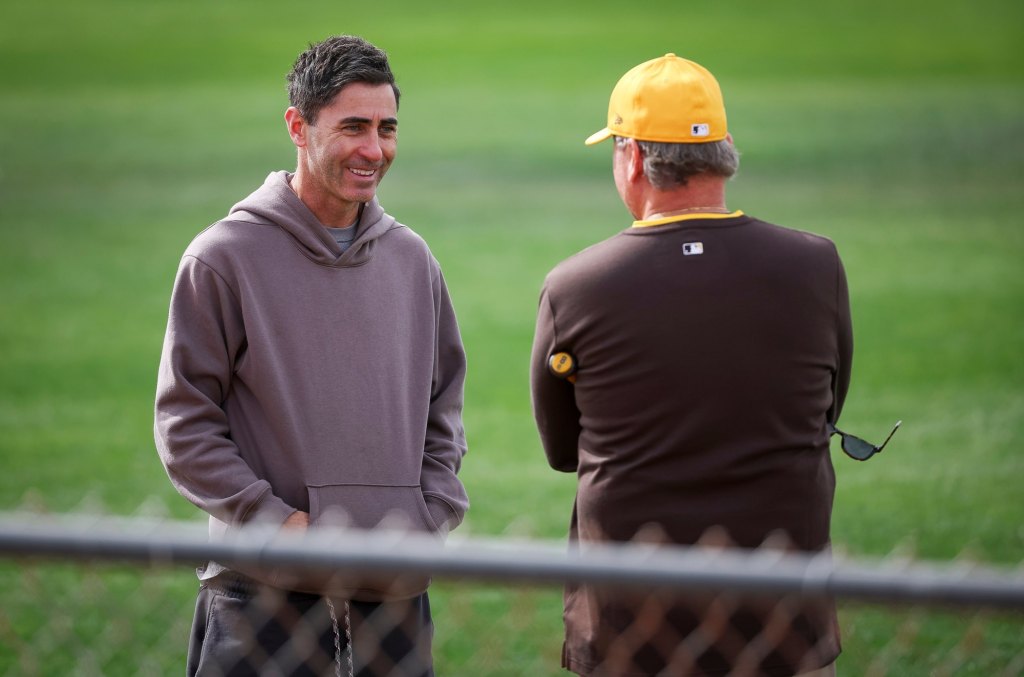It’s a good thing that A.J. Preller responds well to challenges. Because it looks like the Padres’ president of baseball operations won’t have a whole lot of purchasing power going into the July 31 trade deadline.
Start with team ownership and the club’s ability to increase the payroll.
This is the team’s first summer trade market under John Seidler, who was approved as the Padres’ control person by Major League Baseball on Feb. 6. The ongoing legal dispute among Padres shareholders means it’s even tougher to project what decisions will be made on payroll — and even who will make them.
The case for raising the payroll, if that’s even possible, starts with this: the Padres — now 45-39 following Monday’s 4-0 loss to the Phillies in Philadelphia — have a realistic shot at earning their fourth wild-card playoff berth in six years.
With Manny Machado and Xander Bogaerts in their early 30s and due about $300 million and $200 million, respectively, there’s an argument for pushing harder now before their peak years recede further. Yu Darvish, 38, would fall into the argument, too, if the Padres are confident he will return this season.
Padres fans deserve consideration, too. They’ve enabled the club to outdraw the Yankees, Red Sox and Mets in home attendance this year, trailing only the Dodgers.
Should Padres ownership reciprocate, spending more?
On the other hand, the Padres’ payroll sits ninth out of 30 MLB teams. More additions would trigger a luxury tax and possibly a second-level tax that’s more punitive, per FanGraphs.com. I don’t see this year’s team on par with the past three Padres teams, in terms of potential to win the World Series.
Regardless of what ownership decides in terms of payroll, Preller doesn’t seem to have many compelling trade chips.
On the big-league team, there may not be one attractive trade chip outside of the bullpen. The farm system sits in the mid-20s as ranked by mainstream media analysts.
Draft capital matters, too. Because the Padres lack a second-round pick and a competitive balance draft in the amateur draft July 13-14, replenishing the system will be extra challenging. The Padres won’t be making their second selection of the draft until the 99th overall pick. Wild-card race rivals such as the Brewers and Cardinals, for example, will have made five and four picks by then.
If there’s any comfort, it’s this: Preller has done some of his best work when confronted by larger challenges.
Preller’s 2016 trade for Fernando Tatis Jr. heads the list. The Padres landed the future star by trading James Shields, a classic case of turning vinegar into fine wine.
Preller’s response to having to shrink the 2024 payroll by $90 million was also worthy of a chef’s kiss.
Preller traded Matt Carpenter to the Braves, freeing up $5.5 million. To make the trade work, Preller included reliever Ray Kerr, who — once in Atlanta — sustained a torn elbow ligament that cost him the season.
Prreller acquired Luis Arraez from the Marlins only after convincing Miami to pay about $8 million of the hitter’s salary.
Paid just $592,796 by the Padres last season, Arraez improved the team’s offense by batting .366 with men in scoring position and posting an adjusted OPS that was 8% above MLB’s average. The key prospect who went to the Marlins, first-round draftee Dillon Head, suffered a season-ending hip injury. He’s having a subpar 2025 season in the low minors.
Jason Adam provided the Padres with good relief down the stretch following last summer’s trade with the Rays. Accuracy issues have continued to plague pitcher Dylan Lesko, the Padres’ 2022 first-round pick who went to Tampa in the deal. Lesko has logged only 17 innings since leaving the Padres organization.
No prospect Preller sent to the White Sox for Dylan Cease has come close to panning out.
The Marlins are feeling good about their trade that brought Robby Snelling, among others, in the summer trade for closer Tanner Scott and Bryan Hoeing. The left-hander, 21, shows a 3.74 ERA and good underlying stats in 12 Double-A starts this year. Preller was right about Scott, though. He fueled the Padres’ run to the postseason and overwhelmed Dodgers star Shohei Ohtani in the National League Division Series.
Compared to 2024, Preller doesn’t appear to have as many appealing prospects to deal this year — although, to be fair, the Padres’ farm system has exceeded its media grades many times over the past five years.
Per a veteran MLB scout, the Padres’ top prospects are shortstop Leo De Vries and lefty pitcher Boston Bateman, both in Class A. It would be surprising if either is dealt.
But Preller’s high volume of trades suggests he can make a useful addition or two, and that a trade partner will have interest in players signed by Padres scouts out of Latin America.
